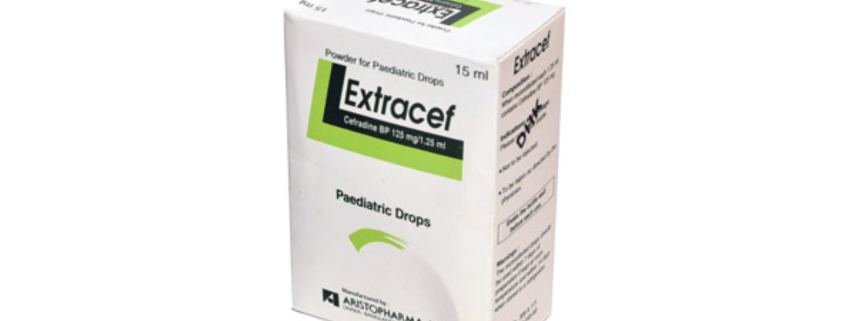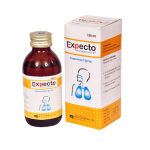Extracef (Cefradine)

Therapeutic Group : Antibiotic
Presentation:
Extracef-250 Capsule: Each capsule contains Cefradine BP 250 mg.
Extracef-500 Capsule: Each capsule contains Cefradine BP 500 mg.
Extracef Powder for Suspension: After reconstitution each 5 ml contains Cefradine BP 125 mg.
Extracef-DS Powder for Suspension: After reconstitution each 5 ml contains Cefradine BP 250 mg.
Extracef Paediatric Drops: After reconstitution each 1.25 ml contains Cefradine BP 125 mg.
Indications:
Extracef is indicated for the treatment of the following bacterial infections: Respiratory tract infections: Tonsillitis, pharyngitis, sinusitis, laryngo-trachitis, acute and chronic bronchitis, lobar and broncho-pneumonia caused by group-A beta-hemolytic Streptococci and Streptococcus pneumoniae. Otitis media; caused by group-A beta-hemolytic Streptococci, S. pneumoniae, Haemophilus influenzae and Staphylococci. Skin and soft tissue infections: Cellulitis, abscess, furunculosis, and impetigo caused by Staphylococci and beta-hemolytic Streptococci. Urinary tract infections: Cystitis, urethritis, pyelonephritis, and prostatitis caused by E. Coli, Proteus mirabilis, and Klebsiella species. Extracef is also used in the treatment of some enterococci (S. faecalis) infections confined to the urinary tract. Perioperative prophylaxis: Extracef may reduce the incidence of certain postoperative infections in patients undergoing surgical procedures including dental procedure.
Dosage & Administration:
Oral:
Adults: The usual dosage range is 1-2 g daily in two or four equally divided doses. Severe or chronic infections may require large doses up to 4 g daily in divided doses or as advised by the physician. Specific dosage recommendation: Respiratory tract infections (other than lobar pneumonia): 250 mg, 6 hourly or 500 mg, 12 hourly. Lobar pneumonia: 500 mg, 6 hourly or 1 g, 12 hourly. In dental procedure: 2 g orally 1 hour before the procedure. Skin & soft tissue infections: 250 mg, 6 hourly or 500 mg, 12 hourly. Urinary tract infections: 500 mg, 6 hourly or 1 g, 12 hourly. Severe or chronic infection may require larger doses (up to 1 g, 6 hourly). Peritonitis: 500 mg 4 times daily, GIT infections: 500 mg 3-4 times daily. Prophylaxis of wound infections: 1-2 g pre-operatively, post-operative dose is adjusted as required.
Children: For children over 9 months, the usual dose is 25-50 mg/kg body weight per day, in equally divided doses, 6 or 12 hourly. For otitis media due to H. influenzae, 75-100 mg/kg body weight per day in equally divided doses, 6 or 12 hourly is recommended.
Contrainidications:
Cefradine is contraindicated in patients with known hypersensitivity to cephalosporin antibiotics.
Warning & Precautions:
Administer cautiously to penicillin-sensitive patient because there were evidences of partial cross-allergenicity between the penicillins and cephalosporins. A modified dosage schedule in patients with impaired renal function is necessary. In patients not on dialysis, the following initial dosage should be as a guideline based on creatinine clearance (Ccr ml/min): 500 mg 6 hourly; when Ccr is >20, 250 mg 6 hourly; when Ccr is 5-20 & 250 mg 12 hourly; when Ccr is <5. For patients on chronic, intermittent hemodialysis 250 mg initially, & repeated at 12 hours and after 36-48 hours.
Side effects:
Adverse reaction reports are rare but include glossitis, heart burn, dizziness, nausea, vomiting, diarrhoea, abdominal pain, vaginitis, candidial overgrowth. Skin and hypersensitivity reactions include urticaria, skin rashes and edema. As with other cephalosporins mild transient eosinophilia, leukopenia, neutropenia and pseudomembranous colitis may be reported.
Drug interaction:
The cephalosporins are potentially nephrotoxic (particularly cephaloridine) and may enhance the nephrotoxicity of aminoglycoside antibiotics such as gentamicin and tobramycin. The nephrotoxicity of cephaloridine is increased by frusemide and one should be cautious about the use of any cephalosporin with frusemide and ethacrynic acid.
Combinations with aminoglycosides may exert more potent bactericidal action against some organisms than agent alone.
Use in special groups:
Use in pregnancy & lactation: Animal studies with Cefradine have shown no teratogenicity. But the safety in pregnancy has not been established. Cefradine is excreted in breast milk and should be used with caution in lactating mothers.
Packing:
Extracef-250 Capsule: Each box contains 30’s capsules in blister pack.
Extracef-500 Capsule: Each box contains 28’s capsules in blister pack.
Extracef Powder for Suspension: Each bottle contains dry powder for the reconstitution of 100 ml suspension.
Extracef- DS Powder for Suspension: Each bottle contains dry powder for the reconstitution of 100 ml suspension.
Extracef Paediatric Drops: Each bottle contains dry powder for the reconstitution of 15 ml drops.



